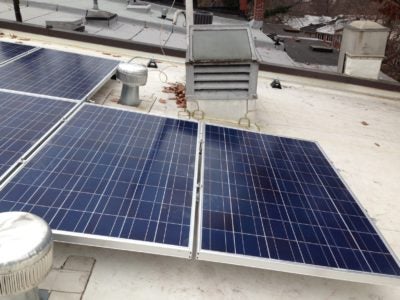Solar for All working groups release recommendations

The D.C. Government has set a target through the Solar for All program of getting 100,000 low-income households access to solar. To achieve this goal, the District Department of Energy and Environment (DoEE) convened a task force to develop recommendations on how to reach this goal. The task force consisted of five separate working groups. The working groups were divided into five topic areas: education, customer acquisition, finance, real estate, and workforce development.
The education group was tasked with developing the process by which the District would engage the public on the program. Key challenges identified by the working group were the need to clearly communicate the program’s goals and accomplishments, as well as how to educate the public about solar technology and its benefits. The group recommended DoEE engage with residents so that they feel involved in this process. This will create much needed transparency around the program.
The customer acquisition group built on this work to figure out how to get these newly educated participants on board with the program. They looked at how the District could develop a pipeline of customers into the program. They recommended the program work with several different programs such as LIHEAP and SNAP to reach low-income customers. The group believes this will help to streamline the process for bringing people into Solar for All.
The finance group determined how Solar for All would be funded. Group members developed several different ways for the DoEE to leverage funds to pay for Solar for All. A finding was if the program is well-implemented, the funds available from D.C.’s Renewable Energy Development Fund would be more than sufficient to provide free energy for low-income households to reduce their bills in half. One key identified by the working group was that the program must start quickly. It must also provide consistent and predicable rules in order to entice long-term investment into the program implementation.
A funded program would still need sites to locate the solar. The real estate group developed recommended strategies to acquire the necessary roof space to power 100,000 low-income households. The group believes the D.C. Government should utilize existing resources to assess opportunities for growth of solar in D.C. on available rooftops, land, brownfields, and canopy space. In addition, the group recommended DoEE prioritize making changes to the building code to ensure structures are “solar ready”. The group also suggested the creation of incentives for large real estate owners to install solar.
Lastly, the workforce group developed recommendations on how adding this much solar could be used to generate and retain local employment. The group recommended the creation of entry-level positions guided toward a career path. This job training programming should be specifically designed for youth and other disenfranchised populations.
Moving forward, the DoEE will look through each subgroup recommendations to gain insight on the best way to implement the program. They are expected to submit an implementation plan to this D.C. Council in February 2017. This is an exciting moment, if successful, Solar for All could be a model and beacon of hope for other cities who are also looking expand solar access to low-income populations.
